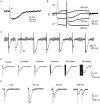Efferent control of the electrical and mechanical properties of hair cells in the bullfrog's sacculus
- PMID: 21048944
- PMCID: PMC2966443
- DOI: 10.1371/journal.pone.0013777
Efferent control of the electrical and mechanical properties of hair cells in the bullfrog's sacculus
Abstract
Background: Hair cells in the auditory, vestibular, and lateral-line systems respond to mechanical stimulation and transmit information to afferent nerve fibers. The sensitivity of mechanoelectrical transduction is modulated by the efferent pathway, whose activity usually reduces the responsiveness of hair cells. The basis of this effect remains unknown.
Methodology and principal findings: We employed immunocytological, electrophysiological, and micromechanical approaches to characterize the anatomy of efferent innervation and the effect of efferent activity on the electrical and mechanical properties of hair cells in the bullfrog's sacculus. We found that efferent fibers form extensive synaptic terminals on all macular and extramacular hair cells. Macular hair cells expressing the Ca(2+)-buffering protein calretinin contain half as many synaptic ribbons and are innervated by twice as many efferent terminals as calretinin-negative hair cells. Efferent activity elicits inhibitory postsynaptic potentials in hair cells and thus inhibits their electrical resonance. In hair cells that exhibit spiking activity, efferent stimulation suppresses the generation of action potentials. Finally, efferent activity triggers a displacement of the hair bundle's resting position.
Conclusions and significance: The hair cells of the bullfrog's sacculus receive a rich efferent innervation with the heaviest projection to calretinin-containing cells. Stimulation of efferent axons desensitizes the hair cells and suppresses their spiking activity. Although efferent activation influences mechanoelectrical transduction, the mechanical effects on hair bundles are inconsistent.
Conflict of interest statement
Figures




Similar articles
-
Mechanoelectrical transduction by hair cells of the bullfrog's sacculus.Prog Brain Res. 1989;80:129-35; discussion 127-8. doi: 10.1016/s0079-6123(08)62206-2. Prog Brain Res. 1989. PMID: 2699361 Review.
-
Rapid, active hair bundle movements in hair cells from the bullfrog's sacculus.J Neurosci. 1996 Sep 15;16(18):5629-43. doi: 10.1523/JNEUROSCI.16-18-05629.1996. J Neurosci. 1996. PMID: 8795619 Free PMC article.
-
Compliance of the hair bundle associated with gating of mechanoelectrical transduction channels in the bullfrog's saccular hair cell.Neuron. 1988 May;1(3):189-99. doi: 10.1016/0896-6273(88)90139-0. Neuron. 1988. PMID: 2483095
-
Compressive nonlinearity in the hair bundle's active response to mechanical stimulation.Proc Natl Acad Sci U S A. 2001 Dec 4;98(25):14386-91. doi: 10.1073/pnas.251530498. Epub 2001 Nov 27. Proc Natl Acad Sci U S A. 2001. PMID: 11724944 Free PMC article.
-
The central nervous system efferent control of the organs of balance and equilibrium.Neurosci Res. 1991 Oct;12(1):13-30. doi: 10.1016/0168-0102(91)90096-h. Neurosci Res. 1991. PMID: 1660981 Review.
Cited by
-
Functional Postnatal Maturation of the Medial Olivocochlear Efferent-Outer Hair Cell Synapse.J Neurosci. 2020 Jun 17;40(25):4842-4857. doi: 10.1523/JNEUROSCI.2409-19.2020. Epub 2020 May 19. J Neurosci. 2020. PMID: 32430293 Free PMC article.
-
Muscarinic Acetylcholine Receptors and M-Currents Underlie Efferent-Mediated Slow Excitation in Calyx-Bearing Vestibular Afferents.J Neurosci. 2017 Feb 15;37(7):1873-1887. doi: 10.1523/JNEUROSCI.2322-16.2017. Epub 2017 Jan 16. J Neurosci. 2017. PMID: 28093476 Free PMC article.
-
Efferent synaptic transmission at the vestibular type II hair cell synapse.J Neurophysiol. 2020 Aug 1;124(2):360-374. doi: 10.1152/jn.00143.2020. Epub 2020 Jul 1. J Neurophysiol. 2020. PMID: 32609559 Free PMC article.
-
Efferent Activity Controls Hair Cell Response to Mechanical Overstimulation.eNeuro. 2022 Jul 8;9(4):ENEURO.0198-22.2022. doi: 10.1523/ENEURO.0198-22.2022. Print 2022 Jul-Aug. eNeuro. 2022. PMID: 35760524 Free PMC article.
-
Mechanical amplification exhibited by quiescent saccular hair bundles.Biophys J. 2015 Jan 6;108(1):53-61. doi: 10.1016/j.bpj.2014.11.009. Biophys J. 2015. PMID: 25564852 Free PMC article.
References
-
- Lewis ER, Baird RA, Leverenz EL, Koyama H. Inner ear: dye injection reveals peripheral origins of specific sensitivities. Science. 1982;215:1641–1643. - PubMed
-
- Strutz J, Bielenberg K. Efferent acoustic neurons within the lateral superior olivary nucleus of the guinea pig. Brain Res. 1984;299:174–177. - PubMed
-
- Fuchs PA, Parsons TD. The Synaptic Physiology of Hair Cells. In: Eatock RA, Fay RR, Popper AN, editors. Vertebrate Hair Cells. New York: Springer; 2006.
Publication types
MeSH terms
Grants and funding
LinkOut - more resources
Full Text Sources
Miscellaneous

